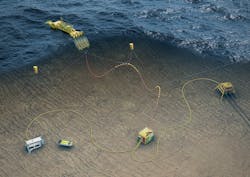Offshore staff
ABERDEEN, UK – Wave power developer Mocean Energy and energy storage specialist EC-OG are working with Chrysaor, Modus, OGTC, and Baker Hughes on a wave-powered renewable energy system for subsea equipment.
The program will aim to demonstrate how wave power, coupled with underwater energy storage, can cost-effectively reduce the carbon footprint of powering subsea oil and gas production equipment and AUVs.
Onshore tests are planned in July and August, with a trial at sea to follow potentially later in the year.
It follows a previous study undertaken by the partners last year, which confirmed the environmental benefits of the design concept.
Cameron McNatt, Mocean Energy’s managing director, said: “In this program, we will demonstrate – in onshore conditions at EC-OG’s facility in Aberdeen – how our wave device will deliver power and communication to subsea equipment.”
Nigel Ward, managing director at Modus, added: “This project will demonstrate the capability to provide temporary or semi-permanent modular series residency for hybrid autonomous underwater vehicles, recharged subsea and controlled from shore using ‘over-the-horizon’ technology.
“This innovative and flexible approach to survey and inspection will reduce the numbers of personnel required offshore, providing significant benefits and cost savings, without compromising quality.”
John Kerr, subsea production systems and technology director for Baker Hughes, Oilfield Equipment said: “Many subsea oilfield production systems will transition to all electric operations in the not too distant future, which will increase operational performance while simultaneously lowering the carbon footprint of the solution.
“We…will be able to simulate the ability of the system to power and communicate with the equivalent of a four well Baker Hughes all electric subsea production system.”
Other subsea applications could include remediation of faulty umbilical cables in existing field developments; fast-track solutions for single-well tiebacks; and ultra-long step outs of greater than 200 km (124 mi), where local renewable power generation could make development more economically viable.
04/15/2021



